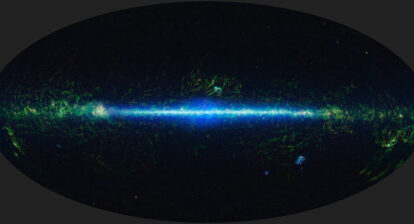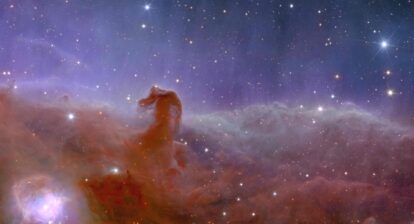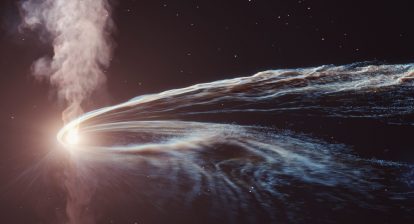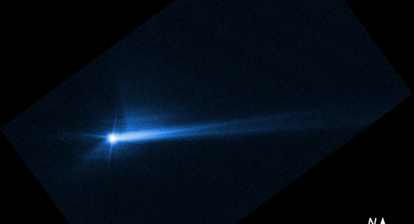Researchers used the Atacama Cosmology Telescope to create a new map of dark matter and this map validates Einstein’s General Theory of Relativity.
The orange regions show where there is more mass; purple where there is less or none. The typical features are hundreds of millions of light years across. The whitish band shows where contaminating light from dust in our Milky Way galaxy, measured by the Planck satellite, obscures a deeper view. The new map uses light from the cosmic microwave background (CMB) essentially as a backlight to silhouette all the matter between us and the Big Bang.
“It’s a bit like silhouetting, but instead of just having black in the silhouette, you have texture and lumps of dark matter, as if the light were streaming through a fabric curtain that had lots of knots and bumps in it,” said Suzanne Staggs, director of ACT and Princeton’s Henry DeWolf Smyth Professor of Physics. “The famous blue and yellow CMB image is a snapshot of what the universe was like in a single epoch, about 13 billion years ago, and now this is giving us the information about all the epochs since.”
“We have mapped the invisible dark matter across the sky to the largest distances, and clearly see features of this invisible world that are hundreds of millions of light-years across, says Blake Sherwin, professor of cosmology at the University of Cambridge, where he leads a group of ACT researchers. “It looks just as our theories predict.”
Dark matter makes up 85% of the matter in the universe but it is very hard to detect because it does not interact with light or other forms of electromagnetic radiation. As far as we know dark matter only interacts with gravity. More than 160 collaborators built and gathered date from the National Science Foundation’s Atacama Cosmology Telescope in the high Chilean Andes. They observed light from the dawn of our universe’s formation known as the Big Bang – a time when the universe was only 380,000 years old. This “baby picture of the universe,” is known as the cosmic microwave background radiation (CMB).
The team tracked how the gravitational pull of gigantic and extremely heavy structures, which include dark matter, warps the CMB from 14 billion years ago (the birth of the universe) to today. This is akin to how a magnifying glass bends light as it passes through its lens.
“We’ve made a new mass map using distortions of light left over from the Big Bang,” says Mathew Madhavacheril, assistant professor in the Department of Physics and Astronomy at the University of Pennsylvania. “Remarkably, it provides measurements that show that both the ‘lumpiness’ of the universe, and the rate at which it is growing after 14 billion years of evolution, are just what you’d expect from our standard model of cosmology based on Einstein’s theory of gravity.”
Sherwin adds, “our results also provide new insights into an ongoing debate some have called ‘The Crisis in Cosmology,’”explaining that this crisis stems from recent measurements that use a different background light, one emitted from stars in galaxies rather than the CMB. These have produced results that suggest the dark matter was not lumpy enough under the standard model of cosmology and led to concerns that the model may be broken. However, the team’s latest results from ACT were able to precisely assess that the vast lumps seen in this image are the exact right size.
“When I first saw them, our measurements were in such good agreement with the underlying theory that it took me a moment to process the results,” says Cambridge Ph.D. student Frank Qu, part of the research team. “It will be interesting to see how this possible discrepancy between different measurements will be resolved.”
“The CMB lensing data rivals more conventional surveys of the visible light from galaxies in their ability to trace the sum of what is out there,” says Suzanne Staggs, director of ACT and Henry DeWolf Smyth Professor of Physics at Princeton University. “Together, the CMB lensing and the best optical surveys are clarifying the evolution of all the mass in the universe.”
“When we proposed this experiment in 2003, we had no idea the full extent of information that could be extracted from our telescope,” says Mark Devlin, the Reese Flower Professor of Astronomy at the University of Pennsylvania and the deputy director of ACT. “We owe this to the cleverness of the theorists, the many people who built new instruments to make our telescope more sensitive, and the new analysis techniques our team came up with.”
ACT operated for 15 years before being decommissioned in September 2022. A new telescope will begin operations in 2024.







